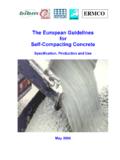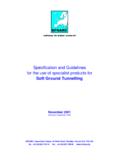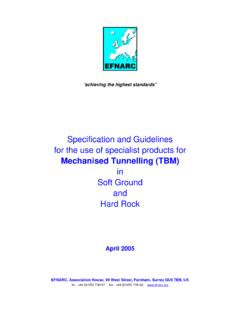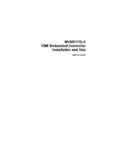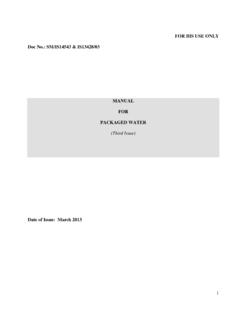Transcription of Self-Compacting Concrete - EFNARC
1 'achieving the highest standards' Specification and guidelines for Self-Compacting Concrete February 2002 EFNARC , Association House, 99 West Street, Farnham, Surrey GU9 7EN, UK tel: +44 (0)1252 739147 fax: +44 (0)1252 739140 0 9539733 4 4 EFNARC 2002 FOREWORD EFNARC is the European federation dedicated to specialist construction chemicals and Concrete systems. It was founded in March 1989 as the European federation of national trade associations representing producers and applicators of specialist building products. Membership has since widened and now includes many of the major European companies who have no national trade association to represent their interests either at national or European level.
2 EFNARC members are active throughout all the countries of Europe. EFNARC main activities at European level and at CEN Technical committees are in flooring, the protection and repair of Concrete , in soft ground tunnelling, in sprayed Concrete , and now in Self-Compacting Concrete . It provides a common voice for the industry to make known its position and view to the European Commission departments dealing with the CPD, CEN Technical Committees and other Groups dealing with European harmonisation of Specifications, Standards, Certification and CE marking relevant to our industry. In each product area it operates through specialist Technical Committees that have been responsible for producing Specifications and guidelines which have become recognised as essential reference documents by specifiers, contractors and material suppliers throughout Europe and beyond.
3 The utilisation of Self-Compacting Concrete (SCC) is growing rapidly. The Concrete community of various European countries intensely researches its application and implements experiences. This Specification and Guideline utilises EFNARC 's broad practical experience with SCC to provide a framework for design and use of high quality SCC. It is based on the latest research findings as well as an abundance of field experience from EFNARC 's members all over Europe. However EFNARC recognises that this is a technology which is still evolving and further advances may require this Specification's requirements to be modified or extended. The responsible Technical Committee will continue to monitor progress in this field and it is our intention to update the document at regular intervals.
4 Feedback from those using this document is therefore invited and will be taken into account at the next revision. All comments on this specification and its requirements should be submitted to: Brian Poulson, EFNARC Secretary-General Little Barn, 2 Beechwood Court, Syderstone, Norfolk, PE31 8TR, UK Tel: +44 1485 578 796 Fax: +44 1485 578 193 E-mail: ACKNOWLEDGEMENTS EFNARC wishes to acknowledge gratefully all the contributions and comments made by members of its SCC Technical Committee and by the participants at its industry workshop at the University of Paisley in December 2001 Although care has been taken to ensure, to the best of our knowledge that all data and information contained herein is accurate to the extent that it relates to either matters of fact or accepted practice or matters of opinion at the time of publication, EFNARC assumes no responsibility for any errors in or misrepresentation of such data and/or information or any loss or damage arising from or related to its use.
5 All rights reserved. No part of this publication may be reproduced, stored in a retrieval system or transmitted, in any form or by any means, electronic, mechanical, recording or otherwise, without prior permission of EFNARC . CONTENTS Page 1 Introduction 4 2 Scope 4 3 Referenced standards 4 4 Definitions 4 5 Requirements for Constituent materials 5 6 Requirements for Self-Compacting Concrete 7 7 Mix composition 8 8 Production and placing 9 9 Quality control 11 ANNEX A Guidance Notes 12 B Checklist 17 C Trouble-shooting guide 18 D Test methods 21 E References 31 Specification & guidelines for Self-Compacting Concrete 4 1 INTRODUCTION Self-Compacting Concrete (SCC) has been described as "the most revolutionary development in Concrete construction for several decades".
6 Originally developed to offset a growing shortage of skilled labour, it has proved beneficial economically because of a number of factors, including: faster construction reduction in site manpower better surface finishes easier placing improved durability greater freedom in design thinner Concrete sections reduced noise levels, absence of vibration safer working environment Originally developed in Japan, SCC technology was made possible by the much earlier development of superplasticisers for Concrete . SCC has now been taken up with enthusiasm across Europe, for both site and precast Concrete work. Practical application has been accompanied by much research into the physical and mechanical characteristics of SCC and the wide range of knowledge generated has been sifted and combined in this guideline document.
7 2 SCOPE The EFNARC Specification defines specific requirements for the SCC material, its composition and its application. The Annexes also include a wealth of useful advice to designers, Concrete manufacturers, contractors, specifying authorities and testing organisations. 3 REFERENCED STANDARDS EN 197-1 Cement ; Composition, specifications and conformity criteria EN 206-1 Concrete Specification, performance, production, and conformity EN 450 Fly ash for Concrete Definitions, requirements and quality control EN 934-2 Admixtures for Concrete Definitions and requirements EN 1008 Mixing water for Concrete EN 12350-1 Testing fresh Concrete : Part 1: Sampling EN 12350-2 Testing fresh Concrete : Part 2: Slump test EN 12620 Aggregates for Concrete EN 12878 Pigments for colouring of building materials based on cement.
8 EN 13263 Silica fume for Concrete Definitions, requirements and conformity control EN ISO 9001 Quality management systems Requirements Note : Some of these EN standards may still be in preparation; the latest version should be referred to. 4 DEFINITIONS For the purposes of this specification, the following definitions apply: Addition Finely-divided inorganic material used in Concrete in order to improve certain properties or to achieve special properties. This specification refers to two types of inorganic additions: - nearly inert additions (Type l); - pozzolanic or latent hydraulic additions (Type ll) Admixture Material added during the mixing process of Concrete in small quantities related to the mass of cement to modify the properties of fresh or hardened Concrete .
9 Binder The combined cement and hydraulic addition in a Self-Compacting Concrete Confined flowability see: Passing ability Specification & guidelines for Self-Compacting Concrete 5 Filling ability (unconfined flowability) The ability of SCC to flow into and fill completely all spaces within the formwork, under its own weight Fines see: Powder Mortar The fraction of the Concrete comprising Paste plus those aggregates less than 4 mm. Paste The fraction of the Concrete comprising Powder plus water and air. Passing ability (confined flowability) The ability of SCC to flow through tight openings such as spaces between steel reinforcing bars without segregation or blocking. Powder (Fines) Material of particle size smaller than 0,125 mm.
10 It will also include this size fraction of the sand. Self-Compacting Concrete (SCC) Concrete that is able to flow under its own weight and completely fill the formwork, even in the presence of dense reinforcement, without the need of any vibration, whilst maintaining homogeneity. Segregation resistance (stability) The ability of SCC to remain homogeneous in composition during transport and placing. Stability see: Segregation resistance Unconfined flowability see: Filling ability Workability A measure of the ease by which fresh Concrete can be placed and compacted: it is a complex combination of aspects of fluidity, cohesiveness, transportability, compactability and stickiness. 5 REQUIREMENTS FOR CONSTITUENT MATERIALS General The constituent materials, used for the production of Self-Compacting Concrete (SCC) shall generally comply with the requirements of EN 206.

